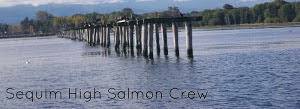Creosote is the name used for many
products, most commonly used in paving roads, roofing, and preserving wood.
There are many types of creosote, but the type that is most widely used as a
wood preservative is called coal tar creosote. Coal tar creosote is introduced
to the water and soil via wood preservative industry. Coal tar creosote can
dissolve into water and move through soil and enter groundwater. If it enters
groundwater, it can take many years for it to break down.
Coal tar creosote is found at the 3 crabs site out at Dungeness. Creosote is found coated on the pilings in the water left from the dock. It is also found on broken off pilings on the shore. The Salmon Coalition is working on removing 2 tons of beached creosote wood and 165 pilings. Creosote is a chemical that can build up in animal and human tissue. Handling creosote-treated wood in fences, bridges, railroad tracks or telephone poles can result in hazardous contact.
Contaminated drinking water can also lead to creosote exposure. Long-term exposure to coal tar creosote can cause skin damage, and it is probable that it leads to cancer. Short-term exposure to coal tar creosote can result in severe skin irritations and eye burns. If swallowed in large amounts it can lead to convulsions, unconsciousness and death. Studies have shown that the eggs of Herring can have a high death rate when exposed to creosote.
Not only was Herring affected but so was the English Sole, which developed liver lesions. These fish are important to the food chain because they are the source of food for Salmon and Orca whales. The Salmon Coalition aims to remove the problematic creosote because of its adverse effects on the environment.
Coal tar creosote is found at the 3 crabs site out at Dungeness. Creosote is found coated on the pilings in the water left from the dock. It is also found on broken off pilings on the shore. The Salmon Coalition is working on removing 2 tons of beached creosote wood and 165 pilings. Creosote is a chemical that can build up in animal and human tissue. Handling creosote-treated wood in fences, bridges, railroad tracks or telephone poles can result in hazardous contact.
Contaminated drinking water can also lead to creosote exposure. Long-term exposure to coal tar creosote can cause skin damage, and it is probable that it leads to cancer. Short-term exposure to coal tar creosote can result in severe skin irritations and eye burns. If swallowed in large amounts it can lead to convulsions, unconsciousness and death. Studies have shown that the eggs of Herring can have a high death rate when exposed to creosote.
Not only was Herring affected but so was the English Sole, which developed liver lesions. These fish are important to the food chain because they are the source of food for Salmon and Orca whales. The Salmon Coalition aims to remove the problematic creosote because of its adverse effects on the environment.
Citation and information found at:
http://www.atsdr.cdc.gov/toxfaqs/TF.asp?id=65&tid=18#top
http://water.epa.gov/type/oceb/marinedebris/upload/creosote_cleanup_puget.pdf
